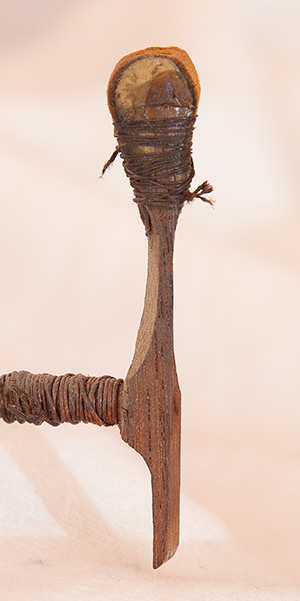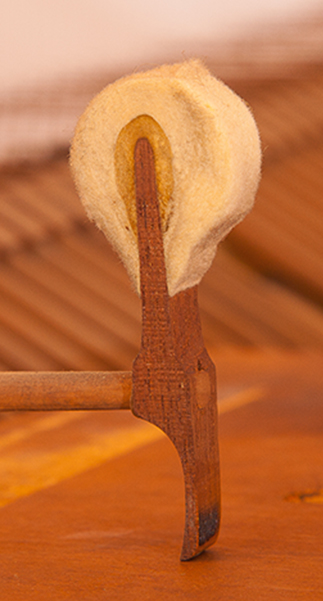Voicing ..
As it sounds, adjusting the voice of the piano.
Tuning is an important "voicing" step.
Regulation is also an important "voicing" step given that it helps the pianist control dynamic.
Still, how the hammer contacts the string and the composition of that hammer is the subject of this short writing.
Below are some interesting examples of hamers needing voicing, although the one in the middle could be considered typical. The two hammers on L and R are original and 154 years old.
 |
 |
 |
The above hammer in the middle would need to be shaped prior to voicing. Shape is important to attack and dynamic range.
The 154 year old hammer on the L had leather added to enhance a brighter attack. The 154 year old hammer on the R was suprisingly resilient and had a very good tone just as it was.
Although shape IS important, also very imortant is the quality of the felt, how it was processed and felted. Higher quality felt, felt of longer strands and more resiliant fibers takes more time to make, is more select therefore more expensive. Cheaper felt is processed more quickly, uses more bleach and harsher chemicals making the felt more brittle and the strands shorter.and the means by which it was pressed into a hammer.
Inexpensive pianos use hammers that are low cost and begin as bright. This kind of thinking continues into moderately priced pianos. It saves the manufacturer money. This is short lived as most people learn there is more to sound than just a bright attack. Inexpensive hammers need far more voicing and in the end, no money is saved by the consumer.
Age wears and hardens all hammers regardless of quality.
It is working with the pianist and these conditions of the hammer/piano that the "voicer" adjusts the piano's tone.
It is possible to "voice" the harshness out of the hammer while voicing in warmth and richness. How much depends on the age, quality and wear of the hammer. Presuming the hammer is not overly worn they can be shaped to improve tone and dynamic range.
The potential of voicing is defined by the piano itself, it's make, size, age and condition. Further, what work has been done previously. Manufacturers use expedients in hammer making such as heat and moisture .. all of these define what can be done. While some genralizing at the beginning is possible as to potential, only actually beginning the process and measuring progress can one truly begin to characterize a potential outcome.
Voicing as a craft vs voicing as an art.
The craft can taught as far as how to use the tools. The art is something learned over a lifetime.
Simple changes can be made quickly and the benefits heard. Very often it is the more complex steps that are needed. Successfully completing these steps in the home requires several visits.
If you are having your piano tuned, this is the best time to ask questions regarding voicing. A piano tuning is a very close inspection of every note in the piano.
